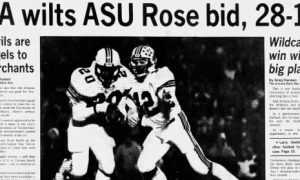Andy Lopez on NCAA snub, ” In SEC you’re rewarded for mediocrity, in Pac-12 you’re punished,” #ArizonaWildcats
— Dave Cooney (@CooneyLand) May 27, 2013
Former Arizona Daily Star reporter Jay Gonzales made a significant point on my Facebook wall regarding Arizona’s omission from the 2013 NCAA Division I baseball tournament field:
“Ridiculous that SEC got 9 teams in and ACC got 8, while the Pac-12 got 4. I can’t believe Stanford and Arizona would not beat the SEC #9 and ACC #8,” Gonzales writes. “You can’t consider yourself a college baseball power conference when your league hasn’t won a title since 1955 like the ACC.
“The Pac-12 has 20 CWS championships during that time. (That doesn’t count the 5 titles won by UA and ASU before they got into the Pac-10.)”
Valid arguments from Gonzales. It’s the equivalent of the NCAA basketball tournament selection committee choosing six teams from the Mountain West and only three from the Big East.
Arizona, the defending NCAA champion, did not make the field despite winning five of its last six games to finish 34-21 overall and 15-15 in the Pac-12.
The geographical makeup of the NCAA Division I Baseball Committee has a majority of members in the east and south, where the ACC and SEC are located. Out of the 10 members, six are from these regions.
They include South Alabama athletic director Joel Erdmann, North Carolina athletic director Larry Gallo, Colonial Athletic Association senior associate commissioner Robert Goodman, Rice athletic director Richard Greenspan, Texas A&M athletic director Eric Hyman and Binghamton associate athletic director for student services Ed Scott.
The four members from the western and midwestern region of the U.S. include Big West commissioner Dennis Farrell (the chairman of the committee), Washington State senior athletic director Randy Buhr, Central Michigan athletic director David Heek and Valparaiso athletic director Mark LaBarbera.
Miami (Fla.) made the 64-team tournament field despite having a losing record in the ACC (14-16). The Hurricanes were 34-23 overall but they had an RPI ranking of No. 19 based on their overall schedule. Miami was 15-15 against the Top 50 RPI teams because of its games against fellow ACC teams.
The lowest RPI-rated team from the ACC is No. 21 Georgia Tech, which finished 34-25 overall and 15-15 in conference play. The Yellow Jackets were 12-17 against top 50 teams.
The lowest rated team from the SEC is Florida at No. 35. The Gators finished 29-28 overall with a 14-16 conference record, laughable marks. Florida was 14-18 against top 50 teams.
Arizona had an RPI of No. 58 and was 5-12 against top 50 teams. The Wildcats were 26-4 against teams rated No. 101 or lower. They were 8-17 against top 100 teams.
Florida was 19-23 against top 100 teams. Georgia Tech was 20-21.
Despite these numbers — indicating Arizona’s record is inferior to the No. 8 team from the ACC and No. 9 team from the SEC — Gonzales’ argument is valid because college baseball is mostly a regional sport. It is not entirely a national sport such as basketball, where inter-sectional games are played between top-ranked teams from different parts of the country.
Georgia Tech’s non-conference schedule included games with Akron, St. John’s, Rutgers, Coastal Carolina, Georgia Southern, Georgia State, Georgia, Mercer, The Citadel, Kinnesaw State, Ohio State and Savannah State. Coastal Carolina, Mercer and Savannah State are the only teams of this group that made the NCAA tournament.
Florida’s non-conference slate included nine teams from Florida: Florida Atlantic, Florida A&M, South Florida, Florida Gulf Coast, Florida State, Miami, Central Florida, North Florida and Jacksonville. The Gators also played Indiana, Georgia Southern and Duke.
Florida Atlantic and Indiana are the only non-conference teams Florida played that made the tournament field.
Another significant question to ask is how William & Mary (37-22) from the Colonial Athletic Conference got in the tournament as an at-large team. The Tribe won only two games (2-5) against top 50 teams. They were 9-12 against top 100 teams.
The Sun Belt (four teams), Big West (three), Colonial Athletic (three), Atlantic Sun (two), Big South (two), Mountain West (two), Southland (two) and West Coast (two) each had multiple entrants, taking spots away from major-college programs.
Go figure: Members of the selection committee are from the Big West, Colonial Athletic and Sun Belt.
Texas A&M made the field with a 13-16 SEC record. The Aggies are 32-27 overall. Their athletic director is on the selection committee.
Go figure.
WILDABOUTAZCATS.net publisher, writer and editor Javier Morales is a former Arizona Press Club award winner. He also writes blogs for Lindy’s College Sports, TucsonCitizen.com and Sports Illustrated-sponsored site ZonaZealots.com.
[rps-paypal]
|
|





























